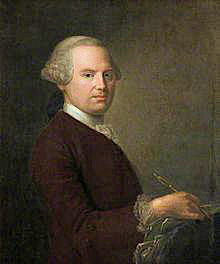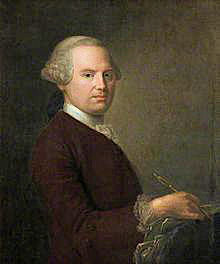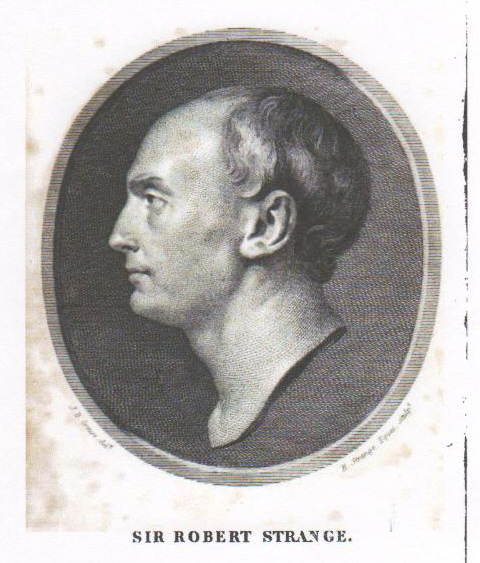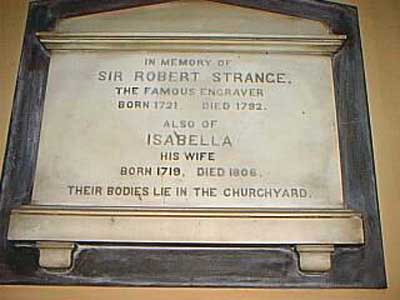Cooper ran an Academy during winter in Edinburgh which Robert attended and greatly improved his skills. About 1741 Robert’s apprenticeship with Cooper ended. Meanwhile Cooper had married, so it was apt that Robert found his own lodgings in Stewart’s Close in Edinburgh, where he started laying the foundations of his own career. However, about 1744, events in love and war were about to overtake the young man, when he made the acquaintance of his future wife, Isabella Lumisden. The Lumisdens were loyal to the Jacobite cause, including the Father, William, Isabella and her brother Andrew. At some juncture, after Charles Edward Stuart had landed in Scotland, Andrew became secretary to the Prince. When he arrived in Edinburgh on his march south with his highland army, Robert, was commissioned to engrave a half size portrait of the Prince. Robert also was recruited into the Prince’s Lifeguards. Robert went with the army into England and all the way back to Culloden. Some time before the battle, when Charlie was resident at Culloden House, there was a problem of finances as the gold shipment from France had been intercepted by the Royal Navy and had fled. A suggestion was made that, as a short measure, they could print bank notes. Andrew Lumisden told the Prince that his friend and future brother-in-law was an engraver, and, possibly could make printing plates. This Robert duly did, getting a blacksmith in Inverness to make two plates, which he duly engraved. These plates were never used, but were lost after the rout in the battle. However, one was found at an auction of Clan MacPherson goods in the 1920s. It is now in the museum in Fort William. Robert managed to escape capture after the battle in June 1746, and, since his name had not appeared in any documents captured by the Hanoverian Army, he was never attained i.e. his name was never added to the list of most wanted in the Bill of Attainder of May 1746. Nor was it included in the Act of Grace the following year when many were pardoned. If the currency plates had been used, things could have been different. As it was, Robert was able to return to Edinburgh, but still to stay hidden. In 1747 he married Isabella Lumisden in secret for obvious reasons. Isabella’s brother, Andrew had had to flee for safety to Rouen in France. In his letters home, he urged Robert to travel to France to study under te Masters there, to improve his art. This he did in late 1748, carrying with him Prince Charles Edward Stuart’s seal which Andrew had had to leave in the safe keeping of his family in Edinburgh. This was the beginning of many travels to France and Italy where Robert greatly improved his art, to such an extent that he was admitted to the august art academies s of France and Italy. He is the only Briton ever to have been admitted to the Acadamia di San Luca in Rome in September 1763. By this time he and Isabella were proud parents of three boys and two girls, and the family were living in London. He made an engraving for George III, of a painting by Benjamin West of two of the Royal children who had died in infancy.The King was so pleased with the result that he knighted Robert on the same day that Robert presented the prints. Sir Robert Strange died at his home at 52 Great Queen Street, Lincoln’s Inn Fields, London on 5th July 1792, London, aged 70 years. He is buried in the Churchyard of St. Paul’s Covent Garden, the actors’ church. There are no tombstones surviving, but there is a plaque on the wall inside to his and Isabella’s memory. Isabella died 23rd February 1806 aged 86 years.
Cooper ran an Academy during winter in Edinburgh which Robert attended and greatly improved his skills. About 1741 Robert’s apprenticeship with Cooper ended. Meanwhile Cooper had married, so it was apt that Robert found his own lodgings in Stewart’s Close in Edinburgh, where he started laying the foundations of his own career. However, about 1744, events in love and war were about to overtake the young man, when he made the acquaintance of his future wife, Isabella Lumisden. The Lumisdens were loyal to the Jacobite cause, including the Father, William, Isabella and her brother Andrew. At some juncture, after Charles Edward Stuart had landed in Scotland, Andrew became secretary to the Prince. When he arrived in Edinburgh on his march south with his highland army, Robert, was commissioned to engrave a half size portrait of the Prince. Robert also was recruited into the Prince’s Lifeguards. Robert went with the army into England and all the way back to Culloden. Some time before the battle, when Charlie was resident at Culloden House, there was a problem of finances as the gold shipment from France had been intercepted by the Royal Navy and had fled. A suggestion was made that, as a short measure, they could print bank notes. Andrew Lumisden told the Prince that his friend and future brother-in-law was an engraver, and, possibly could make printing plates. This Robert duly did, getting a blacksmith in Inverness to make two plates, which he duly engraved. These plates were never used, but were lost after the rout in the battle. However, one was found at an auction of Clan MacPherson goods in the 1920s. It is now in the museum in Fort William. Robert managed to escape capture after the battle in June 1746, and, since his name had not appeared in any documents captured by the Hanoverian Army, he was never attained i.e. his name was never added to the list of most wanted in the Bill of Attainder of May 1746. Nor was it included in the Act of Grace the following year when many were pardoned. If the currency plates had been used, things could have been different. As it was, Robert was able to return to Edinburgh, but still to stay hidden. In 1747 he married Isabella Lumisden in secret for obvious reasons. Isabella’s brother, Andrew had had to flee for safety to Rouen in France. In his letters home, he urged Robert to travel to France to study under te Masters there, to improve his art. This he did in late 1748, carrying with him Prince Charles Edward Stuart’s seal which Andrew had had to leave in the safe keeping of his family in Edinburgh. This was the beginning of many travels to France and Italy where Robert greatly improved his art, to such an extent that he was admitted to the august art academies s of France and Italy. He is the only Briton ever to have been admitted to the Acadamia di San Luca in Rome in September 1763. By this time he and Isabella were proud parents of three boys and two girls, and the family were living in London. He made an engraving for George III, of a painting by Benjamin West of two of the Royal children who had died in infancy.The King was so pleased with the result that he knighted Robert on the same day that Robert presented the prints. Sir Robert Strange died at his home at 52 Great Queen Street, Lincoln’s Inn Fields, London on 5th July 1792, London, aged 70 years. He is buried in the Churchyard of St. Paul’s Covent Garden, the actors’ church. There are no tombstones surviving, but there is a plaque on the wall inside to his and Isabella’s memory. Isabella died 23rd February 1806 aged 86 years.
Bio by: Archie Gilbert
Family Members
Advertisement
See more Strange memorials in:
Records on Ancestry
Sponsored by Ancestry
Advertisement






